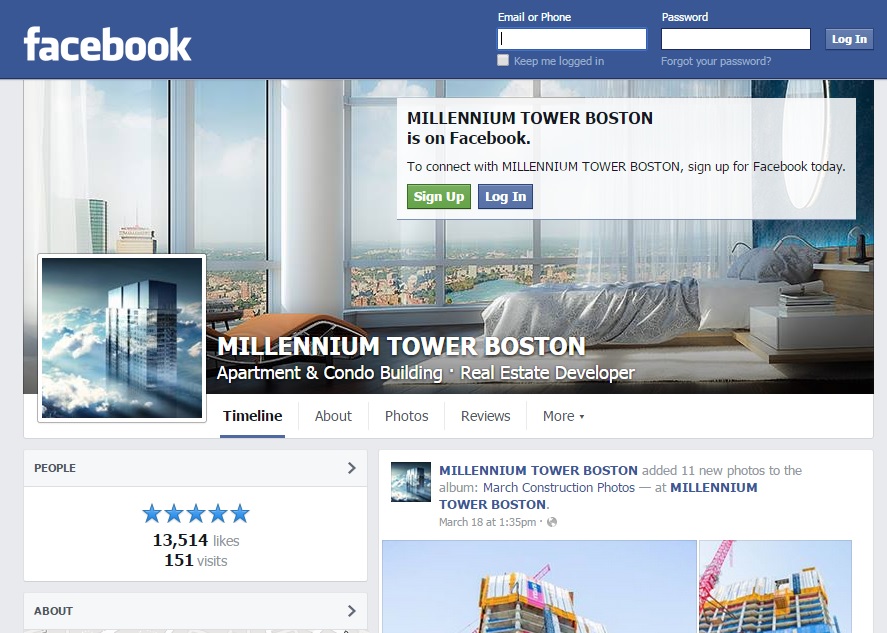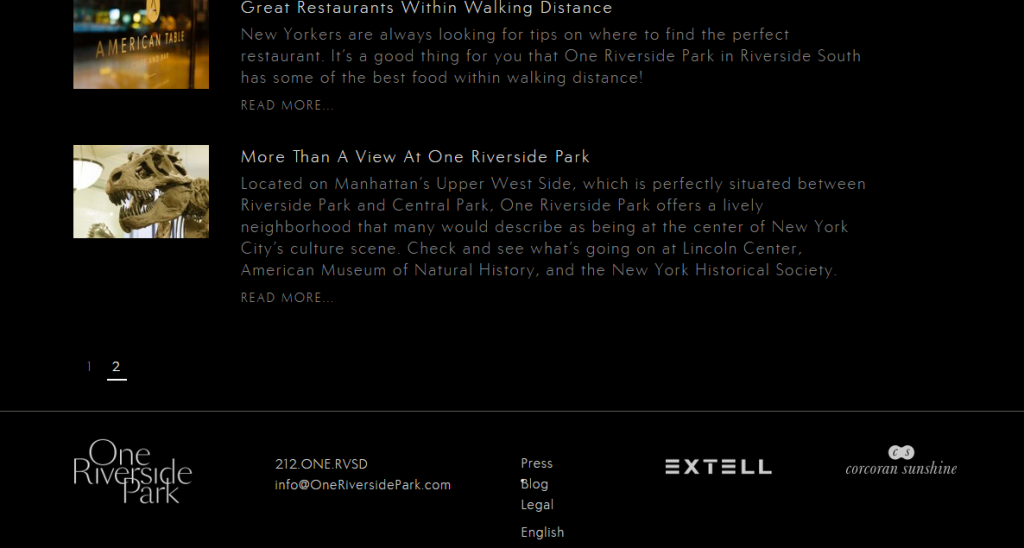
by Fronetics | Jun 30, 2015 | Blog, Content Marketing, Current Events, Marketing

93 percent of all online experiences begin with a search engine and 75 percent of searchers don’t move past the first page of search results. With home buyers increasingly more likely to start their purchasing research online, content marketing is a strategic way for real estate marketers to get their properties in front of more potential buyers. What’s more, home buyers are influenced by peers and their interactions with websites, mobile apps, and social networks. The opportunities created by these online interactions can be competitive advantages for real estate marketers who are prepared to take advantage of this new landscape.
Consider this case study of a leading real estate marketing firm who chose to use digital and content marketing to shake up their traditional marketing approach. After just three months of beginning a digital and content marketing program, the firm recognized significant gains in web traffic, social media engagement, and brand exposure. The firm recognized that unlike print, online mediums created opportunities for their firm to present target audiences with dynamic content. Optimizing their content and strategizing about its distribution boosted sales 37% for this real estate marketing firm in just 90 days.
Download the case study to find out how they achieved their remarkable results.


by Fronetics | Jun 29, 2015 | Blog, Content Marketing, Marketing

In real estate sales, you want people to find your properties, like what they see, and ultimately be moved to purchase. In other words, you want to attract visitors, convert visitors to leads, and convert leads to deals. Innovative luxury real estate firms are finding ways to leverage digital tools to guide more buyers down that path to purchase.
Without a doubt, luxury real estate buyers are a diverse bunch. “One day I have to know all about feng shui, and the next I have to be able to talk to a pig farmer from Iowa,” says one luxury real estate sales executive. “I’m like a chameleon.” And luxury buyers are trending even more heterogeneous – both geographically and demographically. What’s more, they are more connected than ever before due to the proliferation of digital technologies that enable buyers and properties to connect with one another in new and different ways. It’s clear that technology is a strategic way for properties to get in front of more potential buyers; moreover, it creates competitive opportunities for luxury real estate firms that are prepared to adapt to this new landscape.
Many luxury real estate firms are already using digital and social media to carry the lifestyle brand they’ve built around their properties into the online world. With the use of inbound marketing – think of it as the intersection of valuable content, social media, and lead generation – they are creating new virtual “touch points” to connect with affluent, hyper-connected luxury buyers.
What we know about luxury buyers is that they are likely to do purchasing research online; they are influenced by peers and their interactions with websites, mobile apps, and social networks. We also know that 93 percent of all online experiences begin with a search engine, and that 75 percent of searchers don’t move past the first page of search results. Through publishing relevant, quality content, inbound marketing gives luxury real estate marketers the tools needed to make certain their properties are being found online.
According to Sprout Social’s Consumer Engagement Index, which ranks industries by which ones receive the most engagement from customers on social media, the real estate industry is second overall in terms of inbound engagement relative to audience size. But how exactly, are real estate firms using inbound marketing to sell luxury properties? The majority of real estate firms, through the use of social media and blogs, are seeking to draw visitors to a property’s website. Others are putting social media to use for functional purposes such as communicating real-time updates to potential buyers about project timelines or changes in sales office hours.
Of their recent inbound marketing efforts, the New York City-based Corcoran Real Estate Group says they have realized significant benefits. A spokesperson for the company says, “The main thing we’ve seen is that the quality of the referral traffic back into our main website has significantly improved. And not only are we seeing more traffic coming in, but visitors coming in from social media sites are staying longer and looking at more things — something we had also seen with search engines, but not in such large numbers.”
Corcoran isn’t alone in their use of emergent technology and social media strategy to ensure maximum exposure for their luxury properties. Long & Foster’s Luxury Homes e-magazine showcases luxury properties through an extensive online campaign targeting luxury clients. The online campaign drives traffic to the e-book and the website. Similarly, residential homebuilder Polygon Homes currently connects their available luxury properties to over 6,000 people through a multitude of social media platforms. The company’s social followers are linked to relevant articles, outside press coverage, and traditional marketing resources that serve to build on the lifestyle brand of each property.
Real estate firms are also recognizing value in blog content as way to attract visitors and nurture leads. For example, One Riverside Park, a newly-constructed New York City building with luxury condo units for sale, uses their blog to highlight not only their property, but also additional relevant information such as neighborhood amenities, seasonal local weather, and area restaurants.

Boston is experiencing a substantial upsurge in construction of high-end luxury residential units. The Boston Globe reports that “more than 8,000 luxury residential units are expected to be built in Boston during the next three years, doubling the supply of units built in large, luxury complexes since 1960.” And local real estate firms are using inbound marketing to sell those luxury units. Seventy percent of the luxury units at the 60-story Millennium Tower under construction in Boston’s Downtown Crossing neighborhood have been sold. Millennium Partners, the firm responsible for the marketing and sales of the luxury units, has embraced inbound marketing as part of their overall marketing strategy. The firm currently has over 13,500 likes from users on social media. Millennium Tower’s Facebook page not only shares construction progress, sales information, and related press coverage, but neighborhood amenities, industry trends, and an array of visual content that’s more often than not shared widely by followers.

Beyond increased prospect engagement and driving more traffic to their websites, other firms are using inbound marketing as a way to gauge market reception of traditional print marketing materials and the general perception of properties; knowing what resonates online through focus group-like participation is valuable information that marketers are finding bolster their offline marketing efforts. In that same vein, while real estate marketers are realizing value from creating and sharing content, they’re also recognizing the importance of analytics and measurement.
Real estate marketers are using inbound marketing metrics to determine what type of content is inspiring current customers and pulling in new leads. These firms are looking at how their online numbers compare daily, weekly, and monthly and planning content accordingly. Specifically, they’re monitoring measurements like page views, video views, document views, content downloads, and social conversations. They’re examining how sales are impacted by social media and digital content by tracking metrics such as referrals from Facebook, Twitter, Pinterest. Knowing all of these metrics allows for a more nimble real estate marketing strategy– one that’s able to rapidly adapt and engage potential buyers in real-time.
Inbound marketing is a new approach to an old strategy – one that’s putting real estate marketers in charge of the way potential buyers interact with their properties. These marketers are guiding prospects down the road of purchase through lead generation campaigns – capturing emails and other contact information through blog subscriptions and form completions for content downloads. They’re strengthening branding efforts for their properties by building robust online social communities and employing previously untapped sources of referrals. Real estate marketers who use inbound marketing are seeing their properties rank higher in search engine results pages, experiencing a steady increase in their website visitors, and increasing conversion rates of leads and sales. Taking into consideration the changing demographics and increased digital connectedness of luxury real estate buyers, firms that seek to broaden the reach of their marketing efforts through new and emergent technologies will aggressively position themselves as strong competitors in an increasingly competitive luxury property market.


by Fronetics | Jun 24, 2015 | Blog, Content Marketing, Marketing, Social Media

Marketing that drives success and elevates brand position.
Fronetics Strategic Advisors is a management consulting firm. Since the company was founded we have worked with companies to identify and execute strategies for growth and value creation. We have advised and worked with companies on their most critical issues and opportunities: strategy, organization, talent acquisition, performance management, and M&A support.
In addition to the more traditional consulting services we offer, we have working with companies to create and execute marketing strategies that drive success and elevate their brand position within the industry. Unlike other firms, we are able to draw upon our business expertise and align marketing programs with business objectives and, through a data driven approach, are able to deliver results with a targeted ROI.
We work with clients to develop and implement effective digital and content marketing strategies and to create content including blog posts, articles, case studies, eBooks, and white papers. We also offer social media management.
The following are results realized by three of our clients:
Client A
Industry: Consulting
Timeframe: 21 months
Results:
Over the period of 21 months, Client A gained 6 customers and increased revenue by 93%
Traffic to the website increased by 11,045%. Traffic from all sources increased significantly; direct traffic and traffic driven by social media realized the greatest increase.
| Source |
% change |
| Social Media |
82,900% |
| Direct Traffic |
67,800% |
| Organic Search |
9,380% |
| Email Marketing |
5,900% |
| Referrals |
1,030% |
| Total |
11,045% |
Client B
Industry: Real estate
Timeframe: 3 months
Results:
Over the period of 3 months, Client B. realized an 88% increase in inquiries and a 39% increase in home sales.
Traffic to the website increased by 248%. Traffic from social media and from referrals realized the greatest increases.
| Source |
% change |
| Social Media |
894% |
| Direct Traffic |
159% |
| Organic Search |
157% |
| Referrals |
360% |
| Total |
248% |
Client C
Industry: Foodservice
Timeframe: 11 months
Results:
The client has realized a visit to lead conversation rate equal to 50% above the industry average.
The client, per industry standards, realized a savings of 13% per lead.
Traffic to the website increased by 119%. Traffic generated by organic search and social media were the primary drivers of increased traffic.
| Source |
% change |
| Organic Search |
231% |
| Social Media |
166% |
| Direct Traffic |
53% |
| Referrals |
22% |
| Total |
119% |


by Fronetics | Jun 15, 2015 | Blog, Content Marketing, Data/Analytics, Marketing

It’s impossible not to recognize that the business world is changing. Whether it’s the fall of the travel agent as people migrate towards online booking, or the irrelevance of the compact disc as Spotify and iTunes changed the music industry, or how advertising is done. Outbound marketing, such as print ads, TV ads, banner ads, trade shows, telemarketing, and direct mail are no longer what consumers are requiring. According to Forbes, many brands are moving their advertising budgets from television to online videos. The Content Marketing Institute reports that 8 out of 10 people identify themselves as blog readers, and 23% of all time spent online is spent on social media sites. With the rise of the blog, companies have gotten smart about how to reach their current and potential consumers.
In the B2B world things are changing, too, with many executives wanting to gain information through other mediums. The Content Marketing Institute also reports that a majority (80%) of business decision-makers prefer to get information from articles rather than through advertisements.
We know that inbound marketing is effective in garnering consumers’ attention. It’s aligned with a generation of people who want to be educated about the products they’re buying and who are willing to search for those products online. Even with all of this known, it’s important to ask: what is the ROI when it comes to content marketing?
According to Search Engine Journal, inbound leads cost 60% less than outbound leads. In the Harvard Business Review article, How to Profit from “Lean Advertising”, the shoe company DC Shoes is profiled as a model for inbound marketing. In an industry where star athletes are profiled in big-production advertisements via TV commercials, billboards, and magazine ads, the skateboard shoe company decided to take a different route. According to the 2013 HBS article, “Over the past four years they have gotten more than 180 million views—and in 2011 alone, sales jumped 15%. One was YouTube’s most-shared video of 2011; another garnered a million views in its first 24 hours. Paying online media for this type of exposure would cost upward of $5 million.”
Like any new tack in business decisions, relying on case studies from other businesses is helpful, but cost needs to be considered. In order to calculate ROI the cost of content marketing needs to be assessed:
- salaries (if going in-house)
- marketing agency or contractor services
- additional overhead
- distribution costs
- design and publication software
After those costs have been calculated, the next step is to subtract that number from the revenue generated. The Guardian has put forth its simple content marketing ROI calculator:
(Revenue Generated – Cost of Content Marketing) / Cost of Content Marketing = ROI
According to the newspaper, “A simple calculation could say that you drove 1000 visits through a piece of content, and Google Ads would have cost £1 per click, e.g. £1000 to equal the same. If the content only cost £500, you have a saving!”
But with most seemingly simple things, there’s complexity underneath. Dig deeper and ask more questions. Is the money you’re spending on inbound marketing deterring other, less obvious, costs? Would it have cost you more through outbound marketing methods to achieve that same level of visibility than through inbound marketing solutions? Is inbound marketing bringing in customers or closing a deal more quickly than alternative methods (time is money, after all)? Is inbound marketing cutting down the need for staffing in other areas, such as support staff to manage inquiries or support calls?
Some incalculable values from inbound marketing, like consumer preferences, content intelligence, customer relationship strategies, and branding can be hard to tie to a number, but over time you will see that your ROI will become more clear to you as you generate leads, turn leads into customers, and see the result in the form of money gained (American dollars or British pounds!).

by Jennifer Hart Yim | Jun 11, 2015 | Blog, Content Marketing, Marketing
This is a guest post written by Thijs Messelaar. Thijs has more than 15 years’ experience writing, developing content, and informing marketing strategy for various clients, including high tech, higher education, and highly-rated restaurants.
 The best content marketing feels like a great story.
The best content marketing feels like a great story.
In fact, in many ways content marketing gets the most results because it IS a great story. It captures your imagination. It challenges you. It asks for your trust. And, if it’s truly tops, the payoff is big.
In order to get results from your content, a solid content marketing strategy must be in place. No doubt about it. Simply just creating incredible content and walking away from it probably isn’t going to get you what you want.
Key Content Marketing Channels
Content marketing requires a careful scientific approach in order to get results. Content needs to be curated, cajoled, packaged, posted, pruned, repurposed, prettified, shared, shorn, shifted, pushed out, and run up the flagpole.
To get results from your content, your content will have to be created for and/or distributed through key marketing channels like these:
- Your website assets
- Blog
- Landing pages
- Case studies
- Team (clout)
- Accolades and awards
- Resources
- Videos
- Surveys and quizzes
- Infographics
- E-books
- White papers
- Email
- SEO (onsite)/SEM (AdWords)
- Apps
- Social media (organic)
- Retargeted ads (web and social media)
- Social media ads, promoted posts, offers
- Webinars, trainings, and mini-courses
- Podcasts (audio and video)
You need to organize and optimize your sales pipeline by identifying your goals, audience, and your content marketing channels. And like a good scientist, you’ll have to analyze your results and revise your approach, over and again and again.
Examining all aspects of your content marketing strategy – creation, distribution, engagement – on your content marketing ROI is essential.
The Magic of Content Marketing
But without producing the most interesting, the most useful, the most delicious writing, design and ideas to place in these various channels, your content marketing will be dead in the water.
Great content marketing moves you to do something new and unfamiliar. Or it makes you understand something familiar in a new way. And like a really good story, you want to share good content with everyone. It’s affirming (or reaffirming) and engaging and makes you feel its magic. The magic of content marketing that gets results may be found in the sense of clear authority it imparts.
But the magic of a great story is something intangible. It comes from a true place within you (your soul, let’s say) – and connects with your audience (their souls).
But much of the best content marketing is built on novel, engaging, social, physical, and emotional experiences – not solely on rote data analysis.
Douglas Van Praet advances this relatively controversial take on current marketing practices. “We need to generate smiles, tears, or goose bumps—not significant differences correlated at the 95% confidence interval! These are the things that […] data tabulations will never capture, but they are also the things that make us buy brands,” he writes.
Likewise, these key content marketing attributes are also the essential characteristics of our most favorite and enduring stories.
If yours is merely content created for the sake of just churning more content – that is, if you don’t care much for what you’re writing about – your audience won’t care much either. It will curdle the moment they consume it.
Without moving your audience emotionally, you won’t have excited them intellectually, you won’t have made them care about you or gained their valuable (and venerable) trust. And surely your audience won’t hold your story “near-and-dear” to their hearts in a way that compels them to retell it to everyone and anyone who will listen.
The overall result? Well, poor results from your content marketing and ultimately a weakening of your brand’s standing.
Start your content creation from the soul by being yourself and talking about what you love. You’ll make connections and grow your audience just as the best storytellers have always done.
In the end, you’ll succeed with content marketing in ways you never might have imagined possible – and feel good doing it.
That in itself will be a story worth telling.











